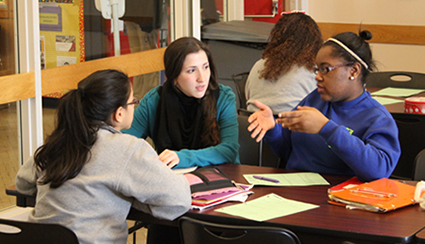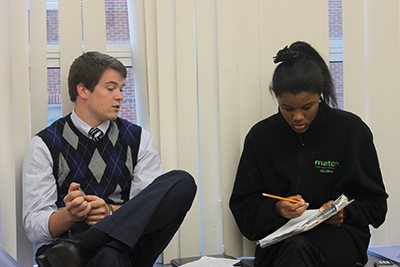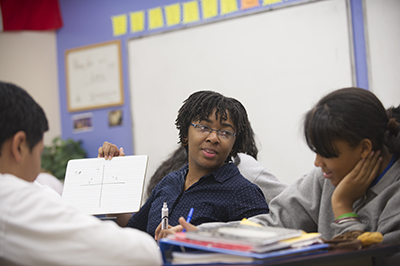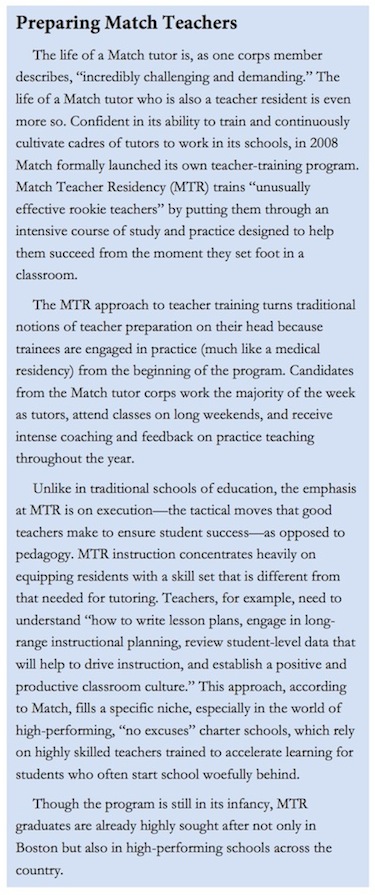Now in its 15th year of operation, Match Charter Public High School is a public-education success story in Boston and beyond. In 2008, when it was still a comparatively young school, Newsweek ranked Match 25th in its list of 1,400 high schools across the nation. U.S. News & World Report ranked it 99th. Finally, in each year between 2008 and 2012, Match High School received the prestigious EPIC Award, granted by the U.S. Department of Education and New Leaders for New Schools, which recognizes urban districts and charter schools “driving the highest achievement gains in students” from year to year.

Photo by Gretchen Ertl / Courtesy Match Education
The accomplishments that have earned Match such recognition are even more impressive in light of the students the school serves: in the 2012–13 school year, 76 percent of Match High School’s student population was classified as low-income, 93 percent of students were black or Hispanic, and 20 percent spoke a first language other than English. According to conventional wisdom, the students Match serves struggle to succeed in public schools. To be sure, many Match students require intensive remediation and “catch-up” upon arrival. The difference is that, unlike too many schools, Match succeeds at helping these students catch up, get ahead, and go on to college. Simply put, Match is proving that the achievement gap can be narrowed and even closed.
While there is no “magic bullet” that can explain Match’s success, many point to a unique feature of the school: a built-in corps of highly educated tutors who live on the school premises and provide students with intense academic support throughout the school day. The Match Corps is not an “add-on” service, nor are tutors mere “teacher helpers.” Tutors are integral to the school day and to students’ academic experience. They are accountable for student learning; they form strong and lasting relationships with students and families; and they are known to all members of the Match community, from full-time teachers to administrators.
Results from the Match Corps model are perceived to be so powerful that many other schools and districts are adopting it. In addition to installing tutor corps in Match Middle School and Match Community Day in Boston, Match has helped charter and traditional district schools in such places as Chicago, Newark, Houston, and Lawrence, Massachusetts, adapt its model to their needs.
A New Approach to Tutoring
In the 2002–03 school year, only two years after it opened, Match High School was emerging as successful. Alan Safran, the school’s former executive director, recalls, “the school was getting good results, performing on par with other high-performing area charters, but we needed to go from ‘good to great.’” At the time, Match leaders knew that their students arrived at 9th grade with roughly a 5 to 10 percent chance of attaining a college degree (based on student demographic background). The leaders wondered what it would take to bolster that chance to 50 percent or more.
Match founder Michael Goldstein thought tutoring might be “what it takes,” but he wasn’t interested in traditional tutoring models. In 2002, Match experimented with “high-dosage” tutoring with a small set of students in 9th-grade math. With help from Harvard statistician Chris Avery, Match analyzed the results for this subset of students; they were dramatic. Those who received tutoring grew substantially more than their counterparts, and their math-class grades grew substantially as well.

Photo by Gretchen Ertl / Courtesy Match Education
Excited about the success of its experiment, Match created a model for hiring dozens of college students—“work-study” tutors—for the 2002–03 and 2003–04 school years. A typical Match sophomore received eight hours per week of tutoring. The tutors were paid $15 an hour, on average, but Match paid roughly $4 per hour of that; the rest was federal subsidy.
Goldstein wanted to know, Is there any way to cost-effectively deliver very high dosage tutoring to all students, not just Match sophomores? Goldstein envisioned a program with full-time volunteers who committed to one year with Match and worked for a small stipend. The difference between his vision and AmeriCorps, however, was that Match volunteers would be singularly focused (more than most AmeriCorps programs) on driving student achievement up in a measurable way.
Goldstein also envisioned that the program could be similar to Teach For America (TFA) in its appeal to elite-college grads. Perhaps most importantly, Goldstein knew that his tutors would have to be highly trained, integrated into the life of the school, and have “high-touch” with students (meaning that they would be present throughout the school day) if they were to be effective. Effective tutors, he thought, would be able to build positive and consistent relationships that would not only enhance academics but also the overall academic experience for students and their families.
While it seemed Match was on to something, several questions had to be answered for the tutor corps program to be implemented at scale: What was the ideal tutor-student ratio? How would the tutors be trained, and how would they be held accountable for student learning? Finally, Match would have to come up with a way to pay for the growth of the tutor corps. For tutoring to be an integral part of the school day, tutors would need to be full-time employees of the school.
Things fell into place. The school’s board of trustees approved the creation of the “Match Corps,” and Match recruited a founding director, Kamala Saxton. In order to make the idea of a paid year of service attractive to graduates from the nation’s top colleges and universities, the school needed to provide housing for tutors who couldn’t otherwise afford to live in Boston on their small stipends (the 2013–14 stipend was $14,300). So the administration raised funds from foundations and individuals and turned the top floor of the school into a dormitory for the tutor corps. Having tutors living on-site had a number of benefits, not least of which was that the school could build its schedule around tutoring—every Match student would have two hours of tutoring each day, which meant that tutors were working throughout the day and could continue to work with students after school, as needed. An AmeriCorps grant covered some of the stipends.
Finding the right tutor-to-student ratio was another challenge. Explains Safran, “a one-to-one ratio may seem desirable, but that means that when a student is doing work, the adult is doing nothing. With a one to three ratio, the adult might be playing defense. One-to-two, we’ve found, is the optimal use of adult time and it is also great for kids. While one student is working, the tutor can engage the other student. Also, with a one-to-two ratio, if you train the tutor and get it right, you can have the kids engage, compete with, and teach each other.”
Prior to the start of school, tutors receive two weeks of intensive training. They learn about strategies for teaching math and English and strategies for working with English-language learners. Tutors also perform simulations with one another and with Match tutor corps administrators. They learn how to handle situations in which students might do “the weirdest things,” and they learn how to handle another major tutor responsibility: communicating effectively with parents.
Every Match tutor is charged with calling parents at least once a week to report on student activities, behaviors, and progress. One might say that tutors are assigned to families rather than to students. Notes former tutor Annie Pinnell, the tutor-parent relationship is incredibly important, “because kids come to know that parents and tutors are on the same team.” Furthermore, the tutor-parent relationship empowers parents to continue the teaching at home: “knowing what we are working on at school allows parents to emphasize the same things at home—kids get a double dose of learning, there is a consistency there that is really important.”
Of course, as with teaching, much of a tutor’s training takes place on the job, and once on the job, Match Corps members receive academic content support from the teachers at the school, who design the content, along with constant feedback from administrators on how that it is being delivered. Once a week, tutors have “practice and planning time,” where teachers give them insight into content and lesson plans and can raise concerns about supports that individual students might require. The same teachers might also weigh in with instructional feedback for tutors, based on what they are seeing in the classroom.
The feedback loop continues with a daily survey that asks tutors to comment on every period of their day: how it went, whether they thought tutoring sessions were productive, and any challenges they might have faced. Considering corps members’ answers to these surveys and drawing upon their own observations, corps directors then provide specific feedback to every tutor on a weekly basis. As described by current Match teacher John Bachner, Pinnell, and others, the feedback is always direct and actionable, so corps members will know exactly why and how to adjust their practice.

Photo by Gretchen Ertl / Courtesy Match Education
Thus far, these pillars of the Match Corps program—1) hire bright young people to commit to tutoring for a year; 2) fully integrate tutoring into the life of the school; 3) provide a strong accountability system to ensure tutor effectiveness; and 4) establish strong relationships between teachers, tutors, parents, and students―have worked well. While it is nearly impossible to disentangle the effects of tutoring on academic achievement from other factors at work in Match schools, such as excellent teaching and a highly structured “no excuses” environment, there is strong anecdotal evidence that the effects of Match Corps are powerful.
Perhaps the strongest evidence comes in the form of state test scores between 2002 and 2005. In 2002, before the inception of Match Corps and the first year in which Match sophomores participated in the Massachusetts Comprehensive Assessment System (MCAS), 20 percent of students failed and 46 percent scored at the needs improvement level. By 2005, the year the tutor corps was fully implemented, 69 percent of sophomores scored at the advanced level in math. The same year, Match ranked 18th in English out of 338 Massachusetts high schools; 32 percent of students tested at the advanced level. Between 2002 and 2005, Match High School reversed student performance on MCAS math: in that time, the majority of sophomores went from struggling to excelling on the test. Importantly, at Match, MCAS success also translated, as Goldstein had hypothesized, into preparing students for college.
By June 2006, Match had graduated three classes, and every student from the classes of 2004, 2005, and 2006 was accepted for admission by a four-year college or university (an average of three acceptances per student), including Boston College, Brown, Duke, Georgetown, Hofstra, Howard, Northeastern, Spelman College, and Trinity College.
There is growing nonanecdotal evidence that the effect of the kind of tutoring that Match has pioneered can be an effective lever for school reform. A 2013 quasi-experimental analysis found that, “on average, extended learning time (ELT) tutorials at Match Charter Public High School raised student achievement on the 10th grade English language arts examination between .15 and .25 standard deviations per year.” This, the author of the study, Matthew Kraft, notes, “is equivalent to approximately an additional year’s worth of instruction.”
This recently quantified evidence of the effect of tutoring was something that Match intuitively knew already. Belief in the impact of the tutoring is so strong and the perceived return on investment from hiring tutors so high that Match Corps quickly went from a program funded by pilot grants to one that the charter school includes in its annual budget. By appealing to tutors’ sense of service, providing a small but livable stipend, organizing low-cost housing for tutors, and above all, by giving tutors a chance to work in a high-performing school as a means for evaluating their interest in education reform and teaching careers, Match can compete alongside Teach For America for the best college graduates in the country and hire three to four tutors for what they pay a full-time teacher.
When pressed to describe why the tutor corps helps Match get the results it does, Match leaders point to this concentrated time with adults and the relationships that develop from that time. Notes Alan Safran,
Match Corps gets to the heart of the human capital question. It’s about more people (adults) building more relationships with students. These adults can get kids to make the effort that they might not otherwise make: good teachers and culture can do so much. How do you get more adults into kids’ lives? How do you set higher standards and provide the support to meet them—you need to do both. If you can do both, this is the Holy Grail.
Jared Taillefer, former Match Corps member, agrees. “Students benefit from feeling known. As a principal, I can shake every student’s hand every morning, but the tutor corps puts that on steroids. It’s about doing individualized instruction right.”
Growing Tutor Corps for National Impact
Locally, charters and even school districts took notice of Match’s strong gains. Boston-area charter networks City on a Hill Charter Public School and Phoenix Academy implemented tutors corps of their own. The results have been meaningful. City on a Hill (COAH), for example, saw a marked rise in its already-strong test scores. In 2008, before the COAH corps was implemented, 67 percent of students scored proficient or higher in grade 10 mathematics and 81 percent scored proficient or higher in grade 10 English. After only one year of a fully implemented tutor corps, those numbers rose to 92 percent proficient or higher in grade 10 mathematics and 94 percent proficient or higher in English. Since then, test scores have remained strong.
 Former Match employees and Match Corps members have also taken the idea beyond Massachusetts. Taillefer began as a Match Corps tutor in the second cohort and went on to be director of development as well as a math teacher and dean of students at Match Middle School and Match High School. He left the organization in 2011 to open Great Oaks Charter Schools in Newark, New Jersey. Taillefer understood from the start that he wanted to bring the model to Newark because he knew of “the individual support that kids in low-income communities need,” and he saw the Match model’s potential “to benefit the community of Newark as a whole.” While Taillefer also adapted the model slightly—specifically adding “blended learning as a more intentional component of the observation/feedback process”—he notes that his school has “otherwise stuck as closely to the model as possible.” He also points out that Great Oaks showed significant improvement in its second year of operation, some of which he attributes to the tutor corps.
Former Match employees and Match Corps members have also taken the idea beyond Massachusetts. Taillefer began as a Match Corps tutor in the second cohort and went on to be director of development as well as a math teacher and dean of students at Match Middle School and Match High School. He left the organization in 2011 to open Great Oaks Charter Schools in Newark, New Jersey. Taillefer understood from the start that he wanted to bring the model to Newark because he knew of “the individual support that kids in low-income communities need,” and he saw the Match model’s potential “to benefit the community of Newark as a whole.” While Taillefer also adapted the model slightly—specifically adding “blended learning as a more intentional component of the observation/feedback process”—he notes that his school has “otherwise stuck as closely to the model as possible.” He also points out that Great Oaks showed significant improvement in its second year of operation, some of which he attributes to the tutor corps.
Match, in turn, is following the lead of Great Oaks. Match Next, which opened in the fall of 2014, employs a blended-learning model similar to that used at Great Oaks. Students work closely with tutors just as they would at any other Match school, but they also spend much of their day using technology targeted specifically to their individual learning needs. In addition, tutors and master teachers use real-time data to challenge and support students with small-group and individualized instruction that not only leverages the technologies that students use but complements them as well.
Researchers have also taken notice of the Match model. Roland Fryer, professor of economics at Harvard University and director of the Education Innovation Laboratory there, wondered if Match’s program and results (coupled with other critical education-reform levers) could be replicated as far away as Houston. His Apollo 20 Initiative used Match-style “high dosage differentiation and tutoring” in an attempt to improve student achievement in nine Houston-area public schools. Other key aspects of the program treatment have been declared “tenets of highly effective charter schools” by Fryer and his team:
• human capital management (holding teachers accountable and rewarding strong performance)
• data-driven instruction
• culture and expectations (getting students to buy into the school’s mission and the importance of education)
• extended school day.
With 257 tutors in nine schools in the first year of the program, middle-school students in Apollo schools received approximately 215 hours of tutoring, and high-school students got about 189 hours. The initial results were promising. Fryer and his team reported statistically significant gains in math for students in Apollo middle and high schools as well as strong high-school English-language arts results. The gains in schools that received “high-dosage tutoring in math were dramatic,” and the study found that although the tenets of the program worked together to produce strong overall results, tutoring was, on its own, “highly effective in increasing achievement.”
The math skills acquired by the average Apollo 20 student represent an estimated three and a half months of additional schooling. Sixth-grade students who received daily math tutoring gained the equivalent of six additional months of schooling. Gains achieved by 9th-grade students ranged between nearly five months of additional learning to more than nine months of additional learning.
One of the most promising things about the Apollo program may be that it demonstrates the capacity of “high-dosage tutoring to work in turnaround contexts.” Very recent evidence from Massachusetts demonstrates that capacity even more clearly. Lawrence, Massachusetts, has long been plagued by poor student achievement. In 2011, the Massachusetts Board of Elementary and Secondary Education declared Lawrence a “chronically underperforming district,” citing years of low test scores and graduation rates.
This declaration empowered Commissioner of Elementary and Secondary Education Mitchell Chester to appoint a receiver to the district, and in early 2012, Chester appointed Jeffrey Riley to the job. Although Riley’s approach to turning around Lawrence has included several key reforms, such as the “implementation of a new curriculum, establishment of Acceleration Academies, and a focus on data-driven instruction,” creating a Match-style tutor corps with help from Match leaders was also a top priority.
The tutor-corps program was launched for all 9th and 10th graders in two high schools during the 2012–13 school year. Lawrence hired and Match trained 50 tutors to serve approximately 600 students; each student received some 150 hours of mathematics tutoring over the course of the school year.
After one full year of implementation at two grade levels in two schools, the results are in: students receiving the Match tutors intervention experienced a 52-point growth (in student growth percentile, or SGP), from 23 to 75. This is unprecedented growth in math and is the greatest one-year change in SGP any high school has seen in math in Massachusetts history.
These results have contributed to historic achievement growth in Lawrence overall.
Beyond Academics
Researchers at the University of Chicago, with support from Match, are trying to answer another question, Are there additional positive effects of such intense academic relationship building?
In the 2012–13 school year, the University of Chicago Crime Lab piloted a program that combines Match-style tutoring in mathematics with an existing sports-based mentoring, known as “Becoming a Man.” The central hypothesis of the study is that tutoring combined with mentoring would decrease violence in the public schools—something that Chicago, a city in which violent crime has plagued the public schools in recent years, sorely needs.
According to the Chicago Sun-Times, the researchers’ hypothesis was confirmed: among the 50 boys who participated in the program in 2012–13, there was a “67 percent reduction in school misconduct.” Based on those numbers, the research predicts “declines in violent crime arrests among the students of 50 to 60 percent over the next year or two—and a drop in drug-related arrests of 40 to 50 percent.” Importantly, the University of Chicago also finds that the effects of Match-style tutoring are significant: mentoring combined with tutoring reduces misconduct more than mentoring alone. These results have garnered high-profile attention. For the 2013–14 school year, the Crime Lab is extending the program to serve more than 500 Chicago-area young men. They are doing so with a $1 million investment from the MacArthur Foundation, a $2 million grant from the City of Chicago pledged by Mayor Rahm Emanuel, and an additional $1 million from a private source.
There is other anecdotal evidence to suggest that the relationships tutors forge with students, and perhaps the act of tutoring itself, has a socio-emotional impact on young people. As Goldstein says, it’s becoming more and more relevant to ask, “What are the soft benefits of tutoring?” Some would argue that there are many. Following the Apollo 20 experiment in Houston, one observer noted in a Houston Chronicle op-ed:
I have witnessed phenomenal behavioral and academic changes in the students. I have seen apathetic students change to students who are excited, enthusiastic learners; students who were failing every subject become engaged in learning and making better grades; students who, in the past, avoided talking with me about their grades, come…waving their report cards in their hands to show me their improvement; students who thought of themselves as incapable begin to think of themselves as capable learners; and students who thought that dreams were for others, begin to dare to dream about the world outside their school and community and how they can contribute.
Evidence of student growth that goes beyond academic achievement drives home what so many of the Match leaders and corps members underscored as central to understanding Match Corps: tutoring Match-style is about human capital, relationship building, and providing students with the confidence to succeed, not only in school but in life.
For a Match-style tutor corps to work, certain conditions must be in place. Schools and districts must have the freedom to, as Goldstein puts it, “build the school day around tutoring.” They must also have the autonomy over scheduling and budgets to get the tutor corps approach right. But for much less than school reform efforts such as reduced class size or extended school day, “high-dosage,” integrated tutoring produces substantially better results. Moreover, it seems clear that there are nonacademic benefits that may be quantifiable in the future, as the model spreads and becomes integrated with other initiatives, such as violence and gang prevention in Chicago. The tutor-corps innovation should hold great promise for policymakers, especially those focused on how to turn around some of the nation’s poorest-performing schools and school districts. As has been shown in places like Houston and Lawrence, Massachusetts, high-dosage tutoring can be an effective lever for school improvement.
Cara Stillings Candal is an education researcher and writer. She is senior consultant for research and curriculum at the Center for Better Schools/National Academy of Advanced Teacher Education and a senior fellow at the Pioneer Institute. This article was adapted from “Matching Students to Excellent Teachers: How a Massachusetts Charter School Innovates with Teacher Preparation” and “Matching Students to Excellent Tutors: How a Massachusetts Charter School Bridges Achievement Gaps,” Pioneer Institute, 2014.


